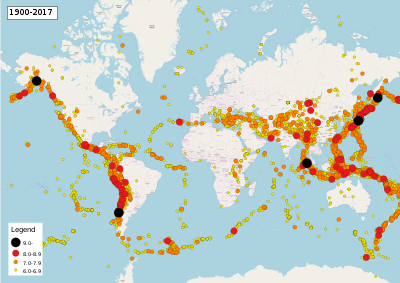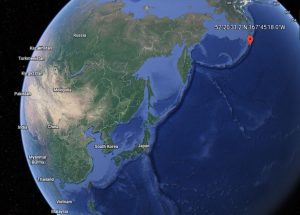Your Solid Ground is Moving; Earthquakes Around the World
How do the earthquakes start?

The earth’s crust is the top layer that moves around like puzzle pieces. Also The edges of the puzzle pieces are rough the get stuck on each other then it causes a earthquake. Earthquakes can be felt in 3 ways over time; when they first get stuck you can feel a foreshock, before a big slip the mainshock. An after shock is like the echo of the main shock. From the beginning to end an earthquake can occur over long period of time.
How many people do earthquakes kill each year?
From 2000 to 2015 the lowest number was 231 deaths in 2000 and the highest in 2004 was 298,101 thousand deaths. The reason it was so high in 2004 was because of the tsunami in Indonesia . Earthquakes can cause tsunami the ocean tides to rush for miles. Tsunami are most dangerous when they hit places like south east asia because they was not a warning system and had houses that were not

Where do earthquakes most occur or happen
“Earthquakes can strike any location at any time, but history shows they occur in the same general patterns year after year, principally in three large zones of the earth” The Pacific coast line is a part of the ring of fire. This is formed by the large Pacific plate of earths’ crust. The Pacific Plate is the largest tectonic plate and it contains a hot spot of volcanoes in the Hawaiian islands. The rubbing and stuck tension over time of the Pacific Plate against other tectonic plates causes a lot of earth quakes to start or happen.
Why are some earthquakes more deadly?
The poor areas get hurt the most because they don’t have any money and they are crowed with poor people. The earthquakes that effect the most people are in a poorer place than a wealthier place because the poor place has less strong building supplies and cant afford good buildings that protect them from earthquakes like the wealthy people. Haiti is the poorest country in the western hemisphere. It is located on the western side of the Atlantic ridge. Haiti had a 6.0 earthquake in 2010 that killed 200,000 people. Japan is one of the wealthiest nations in east Asia. It is located on the ring of fire and has recorded the most earth quakes annually. In 2011 Japan had an8.9 earthquake that caused a tsunami killing only 10,000 people. This was a major event but less people were killed because of the warning systems in place and the buildings that remained standing.


What is the Ring of Fire?
Volcanic arcs and oceanic trenches partly encircling the Pacific Basin form the so-called Ring of Fire, a zone of frequent earthquakes and volcanic eruptions. The trenches are shown in blue-green. The volcanic island arcs, although not labelled, are parallel to, and always landward of, the trenches. For example, the island arc associated with the Aleutian Trench is represented by the long chain of volcanoes that make up the Aleutian Islands. USGS
The third strongest earthquake in the World occurred in my first year of life.
On December 26th, 2004, a massive 9.1 magnitude earthquake struck off the west coast of northern Sumatra, Indonesia. The third largest earthquake ever recorded lifted the sea floor several meters, causing tsunami waves to ripple out in all directions and race across the ocean. Banda Aceh bore the brunt of the waves just 15 to 20 minutes after the earthquake. Waves in some locations along the Sumatra coast were reported to be 30 meters high. Images from Landsat 5 show the coastline before and after the tsunami struck, revealing where vegetation was stripped from the land. Landsat provides rapid assessments of damage to land resources after natural disasters such as tsunamis, and continues to monitor recover years later. USGS

What location has had the strongest earthquake so far this year?
100 km SE of Nikolski, Alaska
Tectonic Summary
The January 11, 2022, M 6.8 Nikolski, Alaska (Aleutian Islands) earthquake occurred as a result of thrust faulting as the Pacific plate subducts beneath the North America plate at the Aleutian Trench, in the subduction zone extending to the southwest from Alaska. At the location of the event, the Pacific plate converges with North America at a velocity of about 70 mm/yr in a northwest direction, subducting at the Aleutian Trench south of the January 11th earthquake. The focal mechanism suggests slip on either a shallowly dipping or steeply dipping fault trending WSW-ENE. Slip is likely to have occurred on the shallowly dipping fault, consistent with an interface subduction event.
While commonly plotted as points on maps, earthquakes of this size are more appropriately described as slip over a larger fault area. Thrust mechanism events of the size of the January 11, 2022 earthquake are typically about 30 km x 20 km in size (length x width).
The M 6.8 earthquake was followed about 1 hour later by a M 6.6 aftershock. Historically, the section of the Aleutian Arc in the vicinity of the January 11th earthquake has hosted 7 events of M 6.5+ within 100 km since the early 1980s. A much larger M 7.8 earthquake occurred in the vicinity in 1965. A large segment of the shallow subduction zone west of the January 11th earthquake ruptured in the M 8.6 central Aleutians earthquake of 1957, which spawned a large and damaging tsunami locally and also impacted the shores of Hawaii and California. SOURCE USGS


